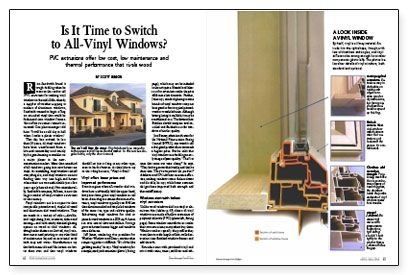Is It Time to Switch to All-Vinyl Windows?
PVC extrusions offer low cost, low maintenance and thermal performance that rivals wood.

Synopsis: A primer on all-vinyl windows, including a comparison of features, methods of construction, and what to look for when choosing this type of window.
Ron Sandwith found it tough sledding when he went on the road to sell PVC extrusions for making vinyl windows in the mid-1980s. Already a supplier of weather stripping to makers of aluminium windows, Sandwith wanted to begin selling an extruded vinyl that could be fashioned into window frames. Most of his customers weren’t interested. One plant manager told him: “It will be a cold day in hell when I make a plastic window.”
That day has arrived. In less than 20 years, all-vinyl windows have been transformed from a low-end commodity used mainly by bargain-hunting remodelers to a major player in the new construction market. More than one-third of all windows going into new houses are vinyl. In remodeling, vinyl windows outsell everything else, and vinyl windows are now finding their way into high-end houses where their use was unthinkable just a few years ago. Not coincidentally, Sandwith’s company, Mikron, is now the largest maker of vinyl-window extrusions in the country.
Vinyl windows are less expensive than comparable primed-wood, vinyl-clad wood and aluminium-clad wood windows. They are made in a variety of styles — double and single-hung, bow, casement, sliders and awning — and with nearly identical glazing options as wood or clad windows. Although color choices are limited, vinyl windows never need painting or any other kind of maintenance beyond an occasional scrub with soap and water. Manufacturers say that both materials and fabrication are better than ever and that vinyl windows should last just as long as any other type, even in harsh climates. As they like to say in the siding business, “Vinyl is final.”
Vinyl offers lower prices and improved performance
Even in regions where all-wood or clad windows have traditionally held the upper hand, low prices have given vinyl windows a real boost. According to estimates from manufacturers, vinyl windows typically cost 30% less than aluminium-clad and vinyl-clad windows of the same size, type and relative quality. Substituting vinyl windows for clad or primed-wood windows in a 2000-sq. ft. house can save several thousand dollars. Savings grow as houses become bigger and windows more elaborate.
Jeff Jones, marketing vice president for Windsor Windows and Doors, cautions that comparing prices is difficult. “It’s a little like grabbing smoke,” he says. Vinyl windows, for example, need jamb extensions which may not be included in the unit price. Material and labor costs for extensions make the price difference less dramatic. Further, Jones says, standard glazing in some brands of vinyl windows may not be as good as that in typical primed wood or wood-clad units. Although better glazing is available, it may be at additional cost. The bottom line: Builders should compare total installed and finished costs for windows of similar quality.
For more photos, illustrations, and details, click the View PDF button below:
Fine Homebuilding Recommended Products
Fine Homebuilding receives a commission for items purchased through links on this site, including Amazon Associates and other affiliate advertising programs.

Homebody: A Guide to Creating Spaces You Never Want to Leave

The New Carbon Architecture: Building to Cool the Climate

All New Kitchen Ideas that Work


























